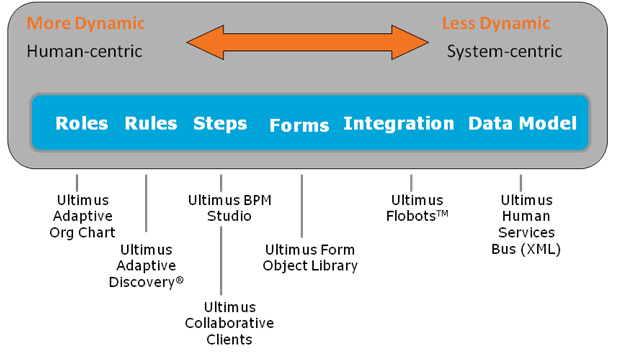Blog activity earlier this week by Jim Sinur categorized today’s processes for a business between structured and “guiding” (or unstructured). I will admit that I have not seen the “guiding” term used to date; yet another new process description term. Despite all of the recent recognition of processes being dynamic in the Business Process Management (BPM) / Adaptive Case Management (ACM) spaces, the majority of processes in business have ALWAYS been unstructured. Following the recent trend of stratifying and categorizing processes, my take on process stratification is:

Thinking back to the inception of automated processes, the reason why workflow technology came first, arguably, is that it is “low hanging fruit”. Like with any large project across the enterprise, the concept of starting small and growing from initial successes is a well understood strategy to achieve large scale success. In the case of satisfying process automation needs across your enterprise, there are two keys to ensure project automation success can extend across the enterprise:
- Do not lock into a technology that ultimately can only reap the “low hanging fruit”
- Do not start with a BPM automation platform that is overly complex and requires long project cycles to achieve even the smallest of successes
This is where Adaptive BPM provides the best solution across your enterprise. As your business processes could arguably be classified as workflows, structured business processes, and adaptive unstructured processes, an Adaptive BPM Suite provides functionality to cover all of these process type needs. Specifically, with an Adaptive BPM Suite platform:
- Workflows can be created, automated, and managed easily and without any coding expertise
- Structured business processes allow for process scalability, process change management
, and the ability to delegate process oversight and administration duties across your company’s work team
- Basic ground works for unstructured business processes where processes can be “partially” defined in the initial stages. Furthermore, these dynamic processes can be extended, matured, and further constructed depending on the process needs and how the company comes to realize how the processes will best work in their company.
This last type of process, the dynamic and unstructured process, requires a specific BPM Suite architecture to supports its use case. If the entire process logic and construction is defined in a single entity, then architecturally, it cannot be dynamic (e.g. there is nothing dynamic in editing and recompiling a large computer program each time any single minor change is needed). So how does an Adaptive BPM Suite architecture look? To support dynamic and unstructured processes, a BPM Suite must be able to break apart the process definition and allow for each part of the process to grow, mature, and be reutilized and repurposed. An example of this architecture would be the following:

Over the next year, there will be many publicized educated opinions about BPM, Case Management and Adaptive Case Management. Rather than decide on a process technology and adjust your process needs to fit that technology, you should think of the opposite. First take an inventory of your existing processes today, the people involved in those processes, and how you expect your process needs to grow over the next 1-3 years. From there, invest in a quality BPM platform that is flexible, dynamic, and adaptive to grow with your process needs.
Relevant Links:
Dynamic and Flexible Routing in Business Processes: Unstructured Processes
BPM Provides Value To Your Case Management Needs
Chris Adams
VP Product and Technology
Ultimus


